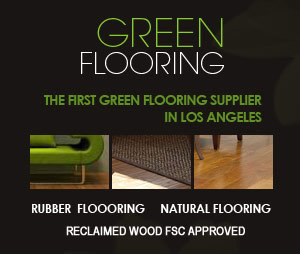902 S. Barrington Ave.
Los Angeles, CA 90049
310-826-8063
1888 S. Sepulveda Blvd.
Los Angeles, CA 90025
310-837-8110
Advances in Flooring: Engineered Bamboo Flooring
About Engineered Bamboo Flooring
The answer to the dilemma lies in engineered flooring. Engineered bamboo flooring is topped with a layer of real bamboo, which is bound to a backing layer. Usually it is an 8-ply base, but the higher the ply count of an engineered bamboo floor, the more stable it is in terms of expansion and contraction due to moisture. This construction allows them to flex with the changes in humidity and temperature, something that solid material would not be able to do.
Where Engineered Bamboo Flooring is Best Installed
Actually, engineered bamboo flooring is even more resistant to moisture than solid hardwood floors. This is especially true when an appropriate underlayment is used.
This moisture resistance makes them suitable for installation in areas such as basements and concrete surfaces where moisture is expected.
Engineered bamboo flooring also offers stability and will resist cupping. This allows homeowners to enjoy a longer lifespan of their flooring materials, even with higher humidity environments.
Engineered Bamboo Floors Are Green Building Materials
Engineered bamboo floors are materials culled from renewable and readily available sources. Bamboo continues to grow even after it is cut, making it a very sustainable product. In other words, harvesting the grass does no harm to the plant, so there is no need for replanting and waiting for new crops to grow. Bamboo is usually harvested in cycles, so every year there is an area ready for use while the other areas mature.
Also, since bamboo grows so well, it doesn’t need fertilizers or pesticides which may harm the balance of the environment. Bamboo flooring has no need for any harsh flooring products as well, so this material is an all around environmentally friendly product from harvest to home. They even offer certain health benefits to asthma and allergy sufferers by resisting dust accumulation and repelling certain insects.
Installing Engineered Bamboo Flooring
One easy way to install your engineered bamboo flooring is to “float” it. Floating engineered bamboo floors are installed over an underlayment which serves as a moisture barrier that protects the floor from being damaged, even if installed in moisture-prone areas. After laying down the moisture barrier, the engineered bamboo flooring planks are then clicked into place on top of the barrier. The tension of the boards against each other hold the floor together, rather than having them fastened to the subfloor.
Choosing Engineered Bamboo Flooring
Engineered bamboo flooring truly is one great flooring option to consider when planning a new property, or even when renovating. It is a truly beautiful flooring option that does not disappoint when it come to strength and durability. Add that to the fact that it is a responsible choice with regard to our environment, and you have a flooring material that is as close to perfect as any product ever will be. Check out some different colors of bamboo floors today to find a look that is right for your home.
May
Log in to post a comment.



Comment